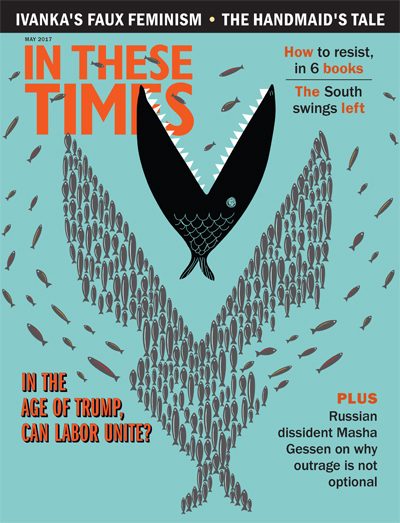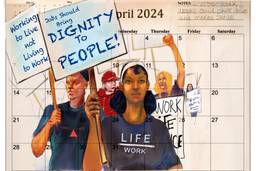A Bank Even a Socialist Could Love
The fight for public banking is gaining ground in cities and states across the country.
David Dayen

“Money is a utility that belongs to all of us,” says Walt McRee. McRee is a velvety-voiced former broadcaster now plotting an audacious challenge to the financial system. He’s leading a monthly conference call as chair of the Public Banking Institute (PBI), an educational and advocacy force formed seven years ago to break Wall Street’s stranglehold on state and municipal finance.
“This is one of the biggest eye-openers of my life,” says Rebecca Burke, a New Jersey activist on the call. “Once you see it, you can’t look back.”
This ragtag group — former teachers, small business owners, social workers— wants to charter state and local banks across the country. These banks would leverage tax revenue to make low-interest loans for local public works projects, small businesses, affordable housing and student loans, spurring economic growth while saving people — and the government — money.
At the heart of the public banking concept is a theory about the best way to put America’s abundance of wealth to use. Cities and states typically keep their cash reserves either in Wall Street banks or in low-risk investments. This money tends not to go very far. In California, for example, the Pooled Money Investment Account, an agglomeration of $69.5 billion in state and local revenues, has a modest monthly yield of around three-quarters of a percent.
When state or local governments fund large-scale projects not covered by taxes, they generally either borrow from the bond market at high interest rates or enter into a public-private partnership with investors, who often don’t have community needs at heart.
Wall Street banks have used shady financial instruments to extract billions from unsuspecting localities, helping devastate places like Jefferson County, Ala. Making the wrong bet with debt, like the Kentucky county that built a jail but couldn’t fill it with prisoners, can cripple communities.
Even under the best conditions, municipal bonds — an enormous, $3.8 trillion market — can cost taxpayers. According to Ellen Brown, the intellectual godmother of the public banking movement, debt-based financing often accounts for around half the total cost of an infrastructure project. For example, the eastern span of the San Francisco-Oakland Bay Bridge cost $6.3 billion to build, but paying off the bonds will bring the price tag closer to $13 billion, according to a 2014 report from the California legislature.
Public banks reduce costs in two ways. First, they can offer lower interest rates and fees because they’re not for-profit businesses trying to maximize returns. Second, because the banks are publicly owned, any profit flows back to the city or state, virtually eliminating financing costs and providing governments with extra revenue at no cost to taxpayers.
“It enables local resources to be applied locally, instead of exporting them to Wall Street,” says Mike Krauss, a PBI member in Philadelphia. “It democratizes our money.”
Legislators, Brown says, commonly object that governments “don’t have the money to lend.” But this misunderstands how banks operate. “We’re not lending the revenues, just putting them in a bank.” That is, the deposits themselves — in this case tax revenues — are not what banks loan out. Instead, banks create new money by extending credit. Deposits simply balance a bank’s books. Public banks, then, expand the local money supply available for economic development. And while PBI has yet to successfully charter a bank, there’s an existing model in the unlikeliest of places: North Dakota.
During the Progressive Era, a political organization of prairie populists known as the Nonpartisan League took control of the state government. In 1919, they established the Bank of North Dakota. It has no branches, no ATMs, and one main depositor: the state, its sole owner. From that deposit base, BND makes loans for economic development, including a student loan program.
BND also partners with local private banks across the state on loans that would normally be too big for them to handle. These loans support infrastructure, agriculture and small businesses. Community banks have thrived in North Dakota as a result; there are more per capita than in any other state, and with higher lending totals. During the financial crisis, not a single North Dakota bank failed.
BND loans are far more affordable than those from private investors. BND’s Infrastructure Loan Fund, for example, finances projects at just two percent interest; municipal bonds can have rates roughly four times as high. And according to its 2015 annual report, the most recent available, BND had earned record profits for 12 straight years (reaching $130 million in 2015), during both the Great Recession and the state’s more recent downturn from the collapse in oil prices. A 2014 Wall Street Journal story described BND as more profitable than Goldman Sachs. Over the last decade, hundreds of millions of dollars in BND earnings have been transferred to the state (although the overall social impact is somewhat complicated by the bank’s role in sustaining the Bakken oil boom).
The long march through the legislatures
Brown founded the Public Banking Institute in 2010, after years of evangelizing in articles and books such as The Web of Debt: The Shocking Truth About Our Monetary System and How We Can Break Free. Since then, by Walt McRee’s estimate, around 50 affiliated groups have sprouted up in states, counties and cities from Arizona to New Jersey.
“I’ve been working against the system all my life,” says Susan Harman of Friends of the Public Bank of Oakland. “I think public banking is the most radical thing I’ve ever heard.” Harman, a former teacher and a onetime aide to New York City Mayor John Lindsay, helped get the Oakland City Council to pass a resolution last November directing the city to determine the scope and cost of a feasibility study for a public bank — a tiny yet promising first step.
A feasibility study completed by Santa Fe, N.M., in January 2016 found that a public bank could have a $24 million economic impact on the city in its first seven years. A resolution introduced last October would create a task force to help the city prepare to petition the state for a charter. “It’s the smallest municipality investigating public banking,” says Elaine Sullivan of Banking on New Mexico, who hopes the task force could complete its business plan by the end of the year. “We’re interrupting the status quo.”
In February 2016, the Philadelphia City Council unanimously voted to hold hearings discussing a public bank. Advocates are now working with the city treasurer to find funds to capitalize the bank.
PBI has faced a rougher path in state legislatures. In Washington, state Sen. Bob Hasegawa (D) has introduced a public banking bill for eight straight years. Despite numerous co-sponsors, the bill can’t get out of committee. Efforts in Arizona and Illinois have also gone nowhere. California Gov. Jerry Brown (D) vetoed a feasibility study bill in 2011, arguing the state banking committees could conduct the study; they never did.
One overwhelming force opposes public banking: Wall Street, which warns that public banks put taxpayer dollars at risk. “The bankers have the public so frightened that [public banking] will destroy the economy,” says David Spring of the Washington Public Bank Coalition. “When I talk to legislators, some are opposed to it because ‘it’s for communists and socialists.’ Like there are a lot of socialists in North Dakota!”
In Vermont the financial industry fought a proposed study of public banking, says Gwen Hallsmith, an activist and former city employee of Montpelier. “We don’t have branches of Bank of America or Wells Fargo in Vermont, but they have lobbyists here.” So Hallsmith got the study done herself, through the Gund Institute at the University of Vermont. It found that a state bank would boost gross domestic product 0.64 percent and create 2,500 jobs.
The state eventually passed a “10 percent” program, using 10 percent of its cash reserves to fund local loans, mostly for energy investments like weatherizing homes. Meanwhile, Hallsmith helped push individual towns to pass resolutions in favor of a state bank— around 20 have now done so. Hallsmith says her advocacy came at the expense of her job; the mayor of Montpelier, in whose office she worked, is a bank lobbyist. Hallsmith now coordinates a citizen’s commission for a Bank of Vermont.
Because of state resistance, PBI has encouraged its supporters to go local. And several issues have emerged to assist. For instance, environmental and indigenous activists have demanded that cities move money from the 17 banks that finance the Dakota Access Pipeline. But therein lies another dilemma: Who else can take the money? Community banks and credit unions lack the capacity to manage a city’s entire funds, and larger banks are better equipped to deal with the legal hurdles involved in handling public money. So divesting from one Wall Street bank could just lead to investing in another.
A public bank could solve this problem, either by accepting cities’ deposits or by extending letters of credit to community banks to bolster their ability to take funds. Lawmakers in Seattle have floated a city- or state-owned bank as the best alternative for reinvestment, and Oakland council member Rebecca Kaplan has connected divestment and public banking as well.
Another opportunity arises with marijuana legalization initiatives. Because cannabis remains illegal at the federal level, most private banks are wary of working with licensed pot shops, fearing legal repercussions. This means many of these shops subsist as all-cash businesses. “It’s seriously dangerous; people arrive in armored cars to City Hall to pay taxes with huge bags of money,” says Susan Harman. In Oakland and Santa Rosa, Calif., public banking advocates are partnering with cannabis sellers to offer public banks as an alternative, which would make the businesses safer while giving the banks another source of capital.
While Donald Trump hasn’t formally introduced a long-discussed infrastructure bill, his emphasis on fixing the nation’s crippling public works has also bolstered the case for public banking. Ellen Brown maintains the country could save a trillion dollars on infrastructure costs through public-bank financing. That’s preferable to Trump’s idea of giving tax breaks to public-private partnerships that want big returns.
From the Great Plains to Trenton
“All it’ll take is the first domino to fall,” says Shelley Browning, an activist from Santa Rosa. “Towns and cities will turn in this direction because there’s no other way to turn.” And PBI members think they’ve found an avatar in Phil Murphy, a Democrat and former Goldman Sachs executive leading the polls in New Jersey’s gubernatorial primary this year.
Murphy has made public banking a key part of his platform. “This money belongs to the people of New Jersey,” he said in an economic address last September. “It’s time to bring that money home, so it can build our future, not somebody else’s.”
Derek Roseman, a spokesman for Murphy, tells In These Times that Bank of America holds more than $1 billion in New Jersey deposits, but only made three small business loans in the entire state in 2015. Troubled state pensions could help capitalize a state-owned bank, and would earn more while paying lower fees.
Murphy’s primary opponent, John Wisniewski, chaired the Bernie Sanders campaign in the state, while Murphy raised money for Hillary Clinton. Some believe Murphy is simply using public banking to cover his Wall Street background — and on many issues, Wisniewski’s policy slate is more progressive. But Brown thinks Murphy’s past primed him to recognize public banking’s power: “It’s always the bankers who get it.”
The first new state-owned bank in a century, chartered in the shadow of Wall Street, could shift the landscape. What’s more, blue-state New Jersey and red-state North Dakota agreeing on the same solution would highlight public banking’s biggest asset: transpartisan populist support. “We have Tea Partiers and Occupiers in the same room liking public banking. What does that tell you?” asks PBI’s Mike Krauss.
“Regardless of declared conservative or progressive affiliations,” says state Sen. Hasegawa, “regular folk … almost unanimously grasp the concept.” He is working with Washington’s Tea Partybacked treasurer, Duane Davidson, to advance public banking. “I go to eastern Washington, … they get the whole issue about independence from Wall Street and corporate control.”
In fact, Krauss is himself a Republican. “The biggest thing going on in America, people decided we don’t have any control anymore,” he says. “Whether it’s Bernie’s people or Trump’s people, they’re articulating the same thing but differently. … They want control of their money — and it is their money.”








